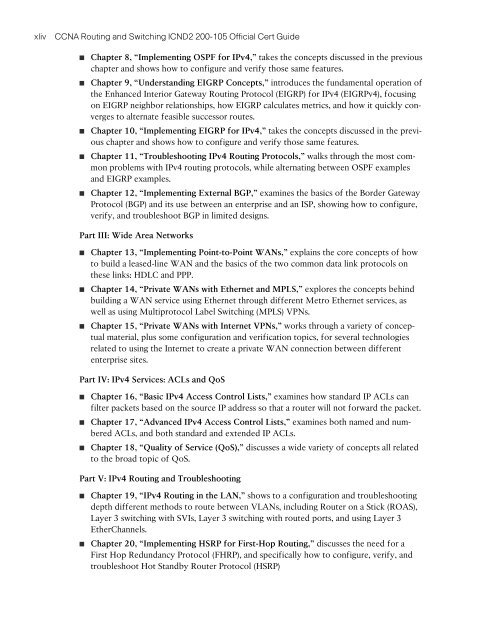CCNA Routing and Switching
HuPe306583u
HuPe306583u
You also want an ePaper? Increase the reach of your titles
YUMPU automatically turns print PDFs into web optimized ePapers that Google loves.
xliv<br />
<strong>CCNA</strong> <strong>Routing</strong> <strong>and</strong> <strong>Switching</strong> ICND2 200-105 Official Cert Guide<br />
■ Chapter 8, “Implementing OSPF for IPv4,” takes the concepts discussed in the previous<br />
chapter <strong>and</strong> shows how to configure <strong>and</strong> verify those same features.<br />
■ Chapter 9, “Underst<strong>and</strong>ing EIGRP Concepts,” introduces the fundamental operation of<br />
the Enhanced Interior Gateway <strong>Routing</strong> Protocol (EIGRP) for IPv4 (EIGRPv4), focusing<br />
on EIGRP neighbor relationships, how EIGRP calculates metrics, <strong>and</strong> how it quickly converges<br />
to alternate feasible successor routes.<br />
■ Chapter 10, “Implementing EIGRP for IPv4,” takes the concepts discussed in the previous<br />
chapter <strong>and</strong> shows how to configure <strong>and</strong> verify those same features.<br />
■ Chapter 11, “Troubleshooting IPv4 <strong>Routing</strong> Protocols,” walks through the most common<br />
problems with IPv4 routing protocols, while alternating between OSPF examples<br />
<strong>and</strong> EIGRP examples.<br />
■ Chapter 12, “Implementing External BGP,” examines the basics of the Border Gateway<br />
Protocol (BGP) <strong>and</strong> its use between an enterprise <strong>and</strong> an ISP, showing how to configure,<br />
verify, <strong>and</strong> troubleshoot BGP in limited designs.<br />
Part III: Wide Area Networks<br />
■ Chapter 13, “Implementing Point-to-Point WANs,” explains the core concepts of how<br />
to build a leased-line WAN <strong>and</strong> the basics of the two common data link protocols on<br />
these links: HDLC <strong>and</strong> PPP.<br />
■ Chapter 14, “Private WANs with Ethernet <strong>and</strong> MPLS,” explores the concepts behind<br />
building a WAN service using Ethernet through different Metro Ethernet services, as<br />
well as using Multiprotocol Label <strong>Switching</strong> (MPLS) VPNs.<br />
■ Chapter 15, “Private WANs with Internet VPNs,” works through a variety of conceptual<br />
material, plus some configuration <strong>and</strong> verification topics, for several technologies<br />
related to using the Internet to create a private WAN connection between different<br />
enterprise sites.<br />
Part IV: IPv4 Services: ACLs <strong>and</strong> QoS<br />
■ Chapter 16, “Basic IPv4 Access Control Lists,” examines how st<strong>and</strong>ard IP ACLs can<br />
filter packets based on the source IP address so that a router will not forward the packet.<br />
■ Chapter 17, “Advanced IPv4 Access Control Lists,” examines both named <strong>and</strong> numbered<br />
ACLs, <strong>and</strong> both st<strong>and</strong>ard <strong>and</strong> extended IP ACLs.<br />
■ Chapter 18, “Quality of Service (QoS),” discusses a wide variety of concepts all related<br />
to the broad topic of QoS.<br />
Part V: IPv4 <strong>Routing</strong> <strong>and</strong> Troubleshooting<br />
■ Chapter 19, “IPv4 <strong>Routing</strong> in the LAN,” shows to a configuration <strong>and</strong> troubleshooting<br />
depth different methods to route between VLANs, including Router on a Stick (ROAS),<br />
Layer 3 switching with SVIs, Layer 3 switching with routed ports, <strong>and</strong> using Layer 3<br />
EtherChannels.<br />
■ Chapter 20, “Implementing HSRP for First-Hop <strong>Routing</strong>,” discusses the need for a<br />
First Hop Redundancy Protocol (FHRP), <strong>and</strong> specifically how to configure, verify, <strong>and</strong><br />
troubleshoot Hot St<strong>and</strong>by Router Protocol (HSRP)


